Secret Agent: Jil Evans and “The Dutch Opera”
Patricia Briggs interviewed Jil Evans at Form+ Content on the occasion of her solo exhibition The Dutch Opera (through May 17). Read on for an extraordinary conversation on how art gets made.
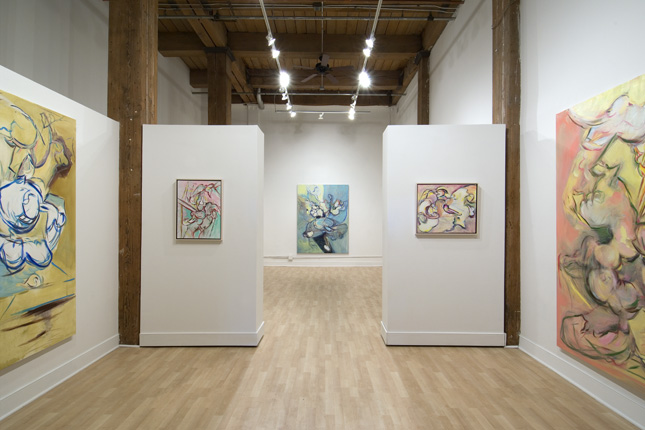
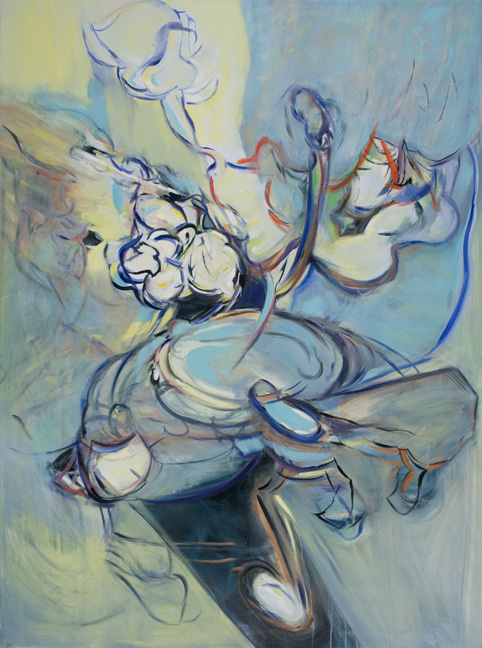

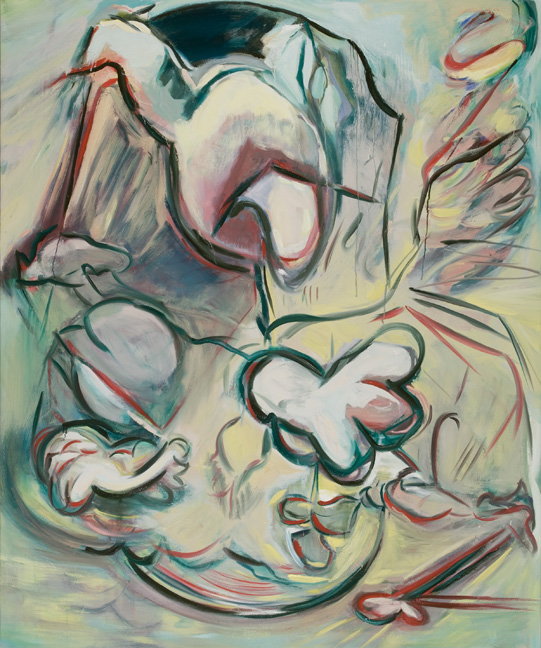
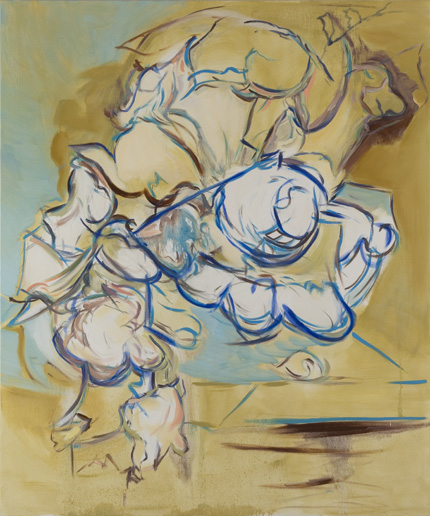
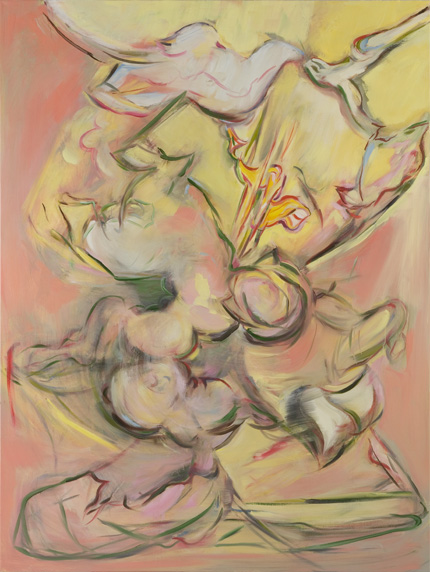
Jil Evans’ exhibition of paintings “The Dutch Opera” represents an interesting intersection of interests. Here, contemporary abstraction meets careful analysis of historical sources in painting, while Evans’s thoughtful approach to aesthetics searches for the ethical dimensions of form and beauty.
Historical Sources
Patricia Briggs: The title of this exhibition of abstract paintings is “The Dutch Opera.” I understand that each image in the show is based on aseventeenth-century Dutch still-life painting. I understand the “Dutch” in your exhibition title, but why “opera”?
Jil Evans: The paintings are made from my sketches of Dutch vanitas paintings. As I started building paintings from the sketches that I made in Oxford, England, at the Ashmolean Museum, I started seeing that the images in my drawings were breaking apart into different figurative aspects. These reminded me of human, animal, and object forms. And there was also a kind of violence evident in my sketches. This made me think of the form of opera with its melodrama and action. But also there is something poignant about the opera narratives –we see it in Shakespeare too—things happen to people because they are in the wrong place at the wrong time. There is a factor of innocence in this that also interests me.
PB: Does the operatic drama come into the work in your process of sketching or in making the painting or do you think it’s in the original source?
JE: I think it is in the original source. I think I’m just finding it. I think the link to the original source keeps the energy and complexity alive. There is something that happens in the forms in the Dutch paintings and something that happens in relationships in the world that is so much more complex and difficult to come to terms with than what I can imagine in my head.
PB: But you are adding to the drama, aren’t you?
JE: Well maybe there is a little of both here–the original drama imbedded or found in the still-life and something of me. A different hand would have drawn something different out of the observations.
PB: Your engagement in this historical work—here and in earlier work that you have done based on [Venetian painter Giovanni] Tiepolo—seems to be more than simply being “inspired” by your source. There is a profound engagement in a kind of visual analysis here. How did this interest in art from the past develop? What is the aim of this practice?
JE: I think for me the investigation of other artists and other paintings is a way of informing my painting with ideas, in addition to the observation of the natural world, or even just my own biography. As a younger person, I had a narrow appreciation of history. I wanted experience of the world–which is really important—but I didn’t appreciate the worlds of experience embedded in other times and places. In the early nineties I spent a year and a half in Oxford during a sabbatical from teaching. While I was there, no one asked me about my background or what I was feeling or thinking about. They wanted to talk about Heidegger, they wanted to talk about ideas all the time. There was so much freedom in that. I thought–this is how I want to live. I want to look at and think about things outside of myself.
PB: That seems very important critically and philosophically. This work is not about “me” (meaning you) even though abstraction is often associated with a sort of explosive self-expression. That is not what you are after at all. The studio is in large part a way for you to study other things, not to necessarily to delve specifically into yourself?
JE: Yes, and the museum too. I do a lot of research in museums, sketching from paintings and other works of art.
PB: You aren’t interested in the evolution of painting, right? You don’t see your work as part of the evolution of painting somehow tied to the seventeenth century?
JE: No, I don’t. I wouldn’t be interested in seventeenth-century painting if I thought there was a linear progression. I don’t think painting has a project. Painting doesn’t have a project; people have projects.
PB: Do you see the development in your own style—which gives form to such a lively world – as tied to your exploration of Baroque works specifically?
JE: Not necessarily the Baroque period, but learning how to see the richness in structures in historical works done in representational styles has given my work energy. It is actually a world I found through the process of drawing. I started drawing from the Dutch still-life paintings because I thought “I haven’t really looked at these paintings before.” I was doing some drawing from flowers, from snapdragons, at the time. As I was drawing, all of sudden I saw all of these creatures and this very dramatic world inside of them. When you work from another person’s work there is a mind there and you find it in the structure of their picture. In looking at a Constable, for example, you see not just a landscape, but a mind. The way Constable marks the end of a marsh or field—there is a metaphor there about the kind of mind at work. You might compare Constable to somebody like Poussin, and over time you can make out the geometry in these universes that emerge out of very different kinds of minds at work. . . .
Rembrandt’s drawings are different from his formal portraits. They have a kind of very quick gesture, almost like a caricature aspect to them. There is so much life there behind the more “finished” formal paintings. So the abstract expressionists didn’t discover anything about putting a mark on a page. The Baroques freed up my hand and gave me confidence about building a painting through drawing.
Body
PB: There is a powerful way that the viewer’s body is hailed by your painting. This is of course like the Baroque art, which uses space to pull the viewer into the drama. Of course in your work the shapes and forms seem to want to burst into our space and engage the viewer phenomenologically. Do I see bodily metaphors here too? Some of the forms remind me of capillaries and intestines. Are those intentional?
JE: Lots of people have said that they see these things in the work. But no, it is not purposeful. I’m not interested in shocking the viewer, but I don’t edit those things out when they come.
PB: I remember hearing you use the term “haptic” to describe your concern. Can you explain?
JE: When I am introducing students to works through slides, I try to impress upon them the idea that when you see a painting (or any work of art, anything) in person, there is something about the physicality of the paint that registers in your psyche before you even recognize what you are looking at: slickness, shininess, dullness, the aesthetic qualities, the actual physicality of the work. Those register and we have a visceral response. So that is what I mean by haptic. These things play on our own memory of touch. Our experience of wet-dry–cool-hot: all those things.
PB: Do you separate optic from haptic? Mind/concept/optical and body/physicality/haptic?
JE: Well, I don’t think I can pull them apart. In a painting, with paint, the optical and touch are linked. The transparency and color of a form are optical, but the way the form is drawn and somehow holds weight and heaviness, that is haptic. For me I think I am trying to develop a vocabulary with painting that brings those things closer together.
PB: Philosophically we can talk about how these things have been pulled apart. The optical and the mind have been elevated while touch and the physical have been more maligned.
JE: Well, it is just part of the nuts and bolts of painting—I need to be conscious of the physicality of paint as a painter.
PB: Yes, but as a painter, do you think that this bringing the haptic and optic together is important to do? Does it speak some truth about experience?
JE: I think it is about intimacy, about touch.
Abstraction, Ethics, Evolution
PB: I like to use this term “becoming” when I see your work. The forms look like they are willing themselves into other forms. Birth and change comes to my mind. But you use the word “metamorphosis.”
JE: I am often looking for that tipping point between something that is being formed and being unformed. Actually, this is what my painting has been part of from the beginning, for the past 25 years. … I think of it as a tipping point between something coming into fruition or something dissolving. That dialectic has always been something that has interested me. It isn’t a conceptual interest so much as it is something I can’t get away from. As soon as I start to create a structure I start to want to take it apart again. It’s almost something that I can’t analyze about my own motives.
PB: Is this tied to your ideas about Darwin?
JE: Darwin is the architect of metamorphosis in biology. In this work I was trying to get at that idea about how metamorphosis needs a restraining force.
PB: Speaking of restraint . . . These original sources—the still-lifes– contain and direct your mark-making in a way that might not happen if these paintings were pure abstractions. It might be that working so intently from your original sources does not allow your painting to be abstract, or expressionism..
JE: Yes, in metamorphosis, how does something keep from becoming just anything? That goes back to the idea of consequence. It is somehow tied into the idea of agency and ethics.
PB: Well, does it have to do with the idea that one can’t have pure freedom?
JE: Well yes, pure freedom probably doesn’t exist.
PB: But lots of art tries to represent pure freedom. How can we tie this back to the work?
Does working from the original source create restraint? Is it this that constitutes a consequence or a resistance?
JE: When I’m making a painting I’m working up against an original source. I am also always making decisions and weighing consequences. I can’t get access to that process, though. It is a kind of painting thinking. When you are in the painting you see relationships and consequences, but they are the result of split-second actions. This is how it is for me. Some painters stare at paintings and ponder these things for hours or days. I seem to need to make those decisions while actually in the process of painting.
PB: But how can forms have consequence?
JE: When I think back to how I started painting, it was sort of barbaric and simplistic. I made a mark. I thought, what if I put another mark over here? What’s that relationship? Am I setting up anything of any consequence here at all? I spent years making drawings of layering marks trying to figure out how I can build a universe where there is a cause and effect without telling a story, without having recognizable subject matter.
PB: I see. You wanted all the drama of consequential action to take shape in your abstractions. It matters that you use a word like “consequence.” You want a pictorial world with consequence.
JE: It’s about agency.
PB: Is this process that you have developed put into action a kind of restrained metamorphosis?
JE: Yes, that is all there really is, there isn’t such a thing as unrestrained metamorphosis. I think it would be very nightmarish to have unrestrained metamorphosis. I also believe that restraint (in this case creating a dialog with an original source) requires my imagination, and challenges me, in a way that painting my fantasies wouldn’t.
PB: Can we come to the issues of ethics, visual form, and the debates around evolution? I’m still trying to see the connections.
JE: I am interested in Darwin because one of the biggest conversations we are having right now in our culture is about trying to answer the question “What is consciousness?” I’m no expert, but the way I understand this is that if you look at the ramifications of a strict reductive view of the person, you wind up explaining away subjectivity and consciousness. Reductive materialism conflates mind with brain and takes away the notion of any transcendent subjective experience. There is no choice? There are lots of determinists in this camp. This would deny the notion that the paintings that I make are informed by choice or free will. The determinist would see the activity of painting as complex, but still somehow ultimately purely physical. But this does not offer any room for consciousness. How can we have any ideas about who we are if it isn’t from consciousness? I don’t think that the determinists explain consciousness. I believe there are lots of thinkers who are trying to keep mind, material, body, and consciousness all together. For me the whole idea of what metamorphosis could be both in the natural world and in painting is tied into this idea about consciousness. So, I find Darwin’s work fascinating and I embrace evolutionary biology, but I have difficulty with the belief that evolutionary biology is the whole story.
PB: The idea of consciousness is bigger than matter and mind for you. It is bigger than both of those things. It is more like life.
JE: Yes, some argue that the foundation of existence is consciousness.
PB: Wouldn’t you say that ultimately that is what you are trying to picture here, a kind of animated materiality? Material form animated with consciousness.
JE: Yes.
PB: It seems like that is at the core of what you are doing.
JE: Yes [laughing], but it seems like a big thing to say.
PB: Material form animated with life or consciousness. It is not just life, but consequential life. It is life with agency and freedom and choice. So these paintings are a way of talking about consciousness.
JE: There are people who think that consciousness emerges from something purely physical. But others think, how could you get something nonphysical (like consciousness) to come out of something physical?
PB: In your work consciousness appears to come before form or the purely physical. You start with the still-life image as a source and it doesn’t seem as if you are trying to impose something on top of it, but rather that you are trying to get in behind them, seeking out or tapping into something profoundly foundational like consciousness.
JE: Yes, perhaps so. These are the ideas that motivate me.